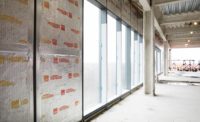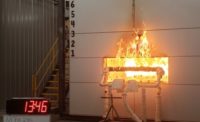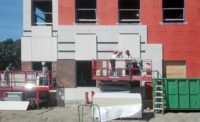In the event of a multi-story building fire, the first line of defense for the occupants is the integrity of the building design. This responsibility places added pressure on commercial architects and specificers to design and specify properly installed, code-compliant fire containment product solutions.
As children, fire prevention education begins with learning how to stop, drop, and roll. Today’s commercial architects and specifiers also use a rule of three in fire prevention and containment design strategy: detective, active, and passive safety systems.
This balanced approach to fire safety begins with the detective systems that include smoke alarms and heat detectors in buidlings. The second line of defense centers on active fire containment systems that include the installation of automatic sprinklers. In the event of a catastrophic fire, the passive containment safety system will help confine the fire to the room of origin by maintaining the integrity of the wall and the floor juncture for the time period designated by codes.
When activated, these three fire safety components will extend the crucial window of time for a large number of commercial building occupants to safely evacuate the structure and fire personnel to access and extinguish the blaze.
An Aggressive Approach to Passive Fire Containment
In any fire, time is of the essence. With a fire in a multi-story structure, this becomes heightened when the means of egress for occupants is limited to elevators and stairways. The elevated heights in these commercial structures also present challenges for emergency fire personnel to access adequate water pressure to reach and extinguish fires in a timely manner.
Yet, one of the least understood and most complex areas where fire can spread in a commercial structure is the perimeter. The reason the perimeter is vulnerable to fire spread centers on the fire sensitivity, especially in curtain wall construction. Heat from fire will typically cause the aluminum framing and aluminum anchors that hold up the exterior wall to melt in approximately nine minutes, causing the wall to disintegrate.
As a result of these factors, it is imperative for architects and specifiers to remain educated on advancements in passive containment systems. This involves understanding both the performance factors of the product solutions as well as specifications and designs are installed correctly and code-compliant.
Perimeter Fire Containment Systems Streamline Installation
In this high-stakes design scenario where commercial building occupants depend on architects and specifiers for their safety, perimeter fire containment system solutions can help alleviate the pressure building designers face to get it right.
Recent advancements in perimeter fire containment systems and educational resources are providing an arsenal of new tools to help architects and specifiers improve accuracy and speed while streamlining design and installation. As a result, building designers are increasingly specifying fire containment systems that incorporate components with proven compatibility, code compliance, and optimal performance without interrupting the overall aesthetic.









Report Abusive Comment